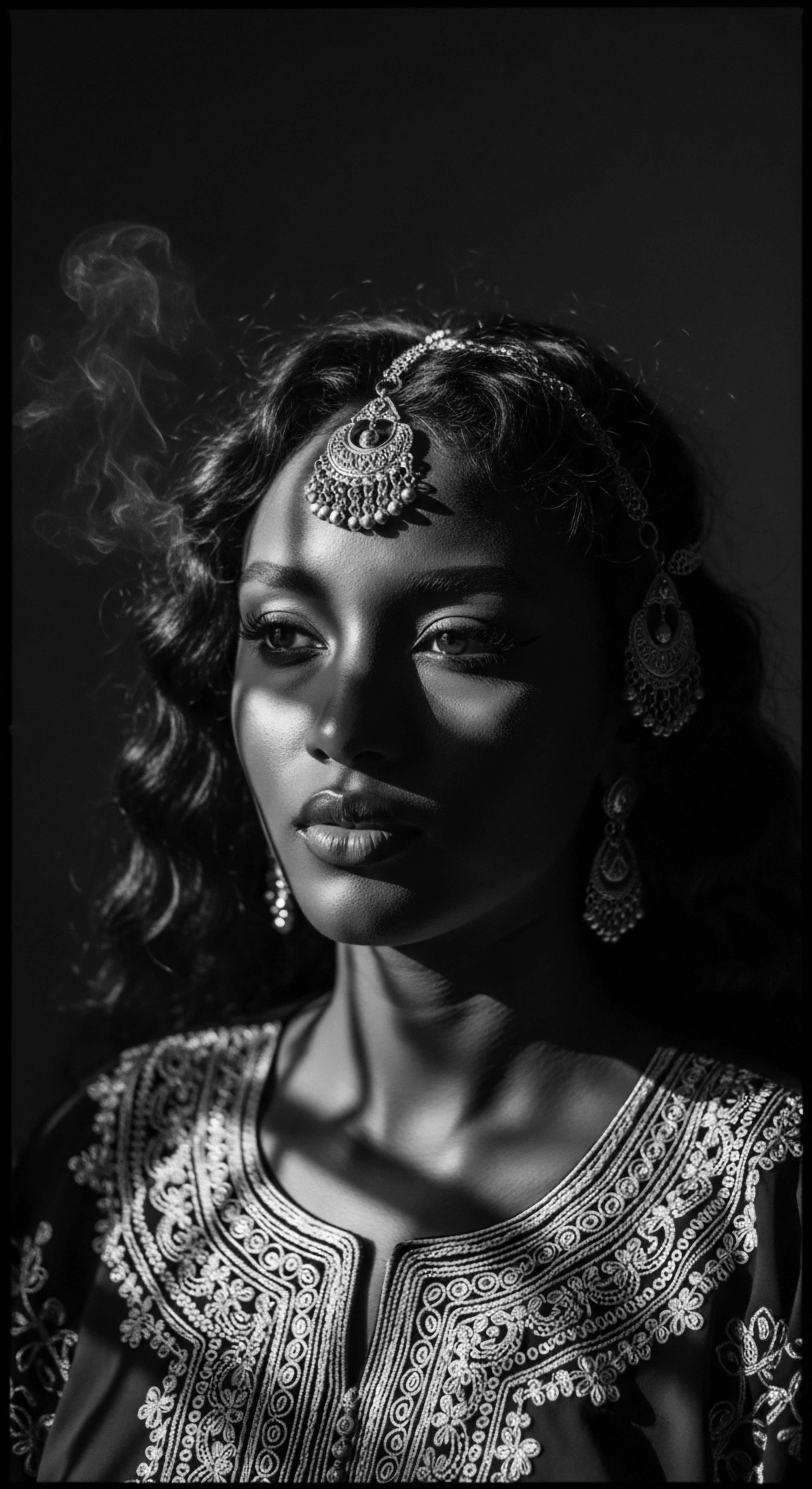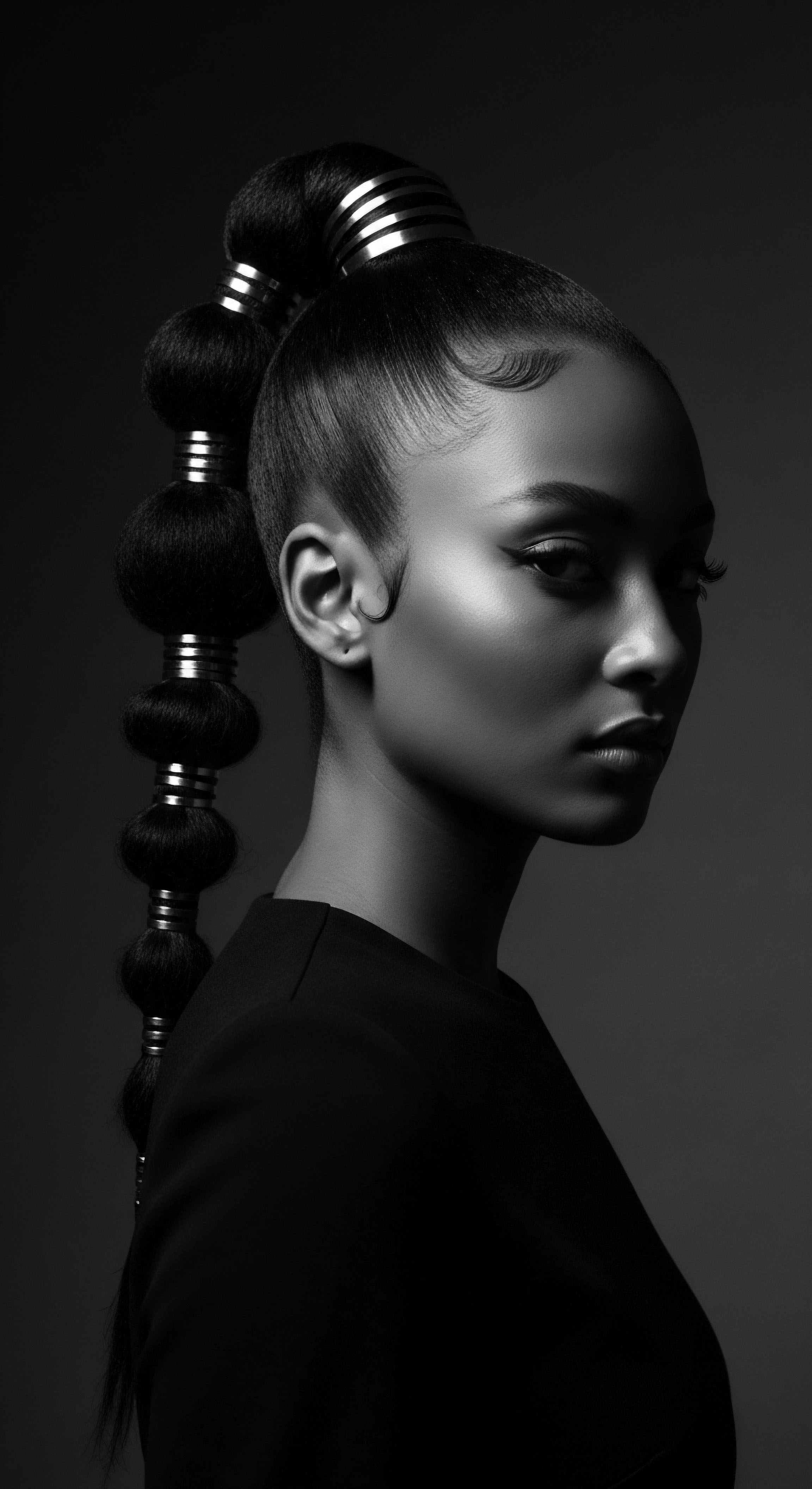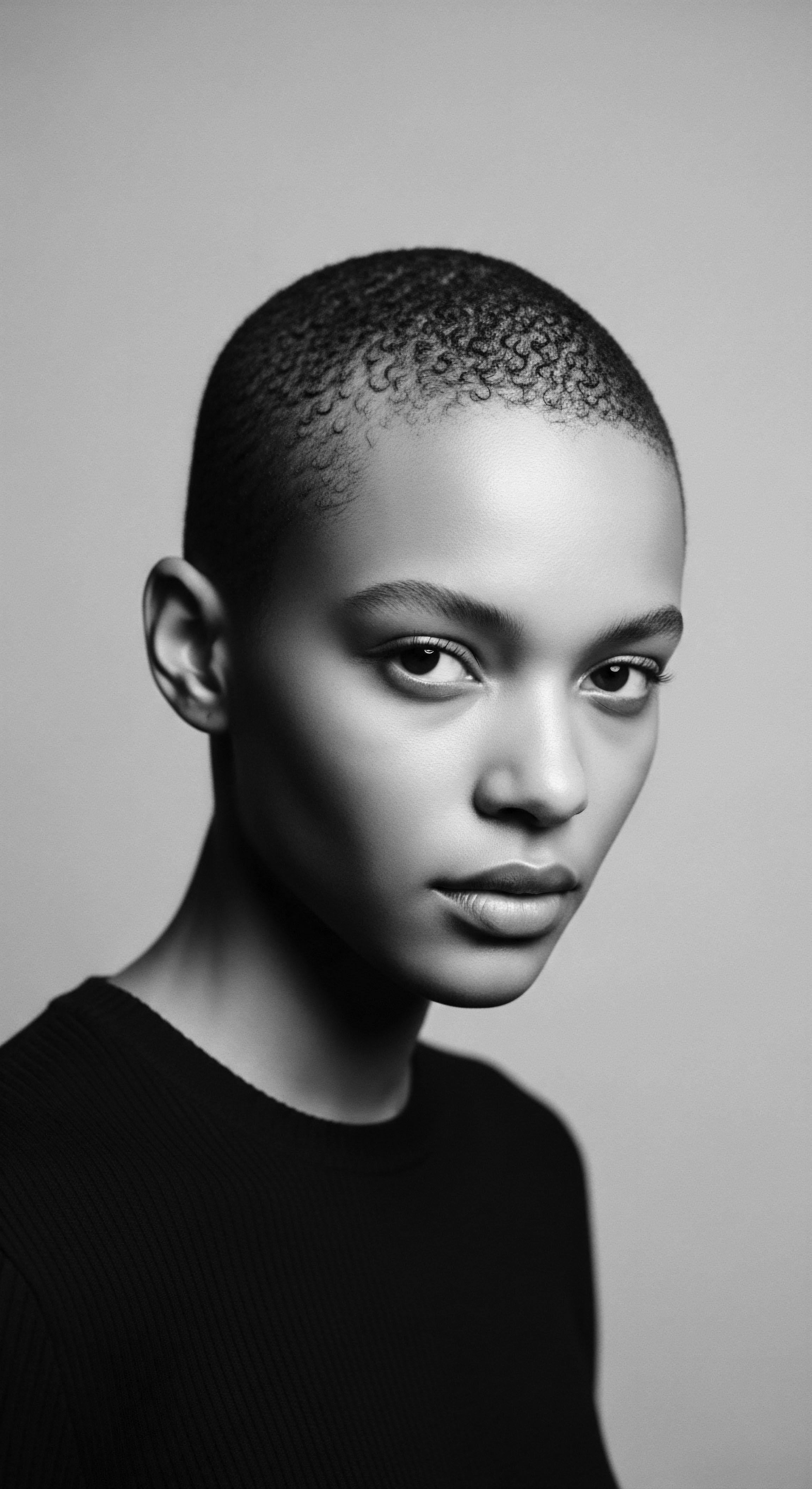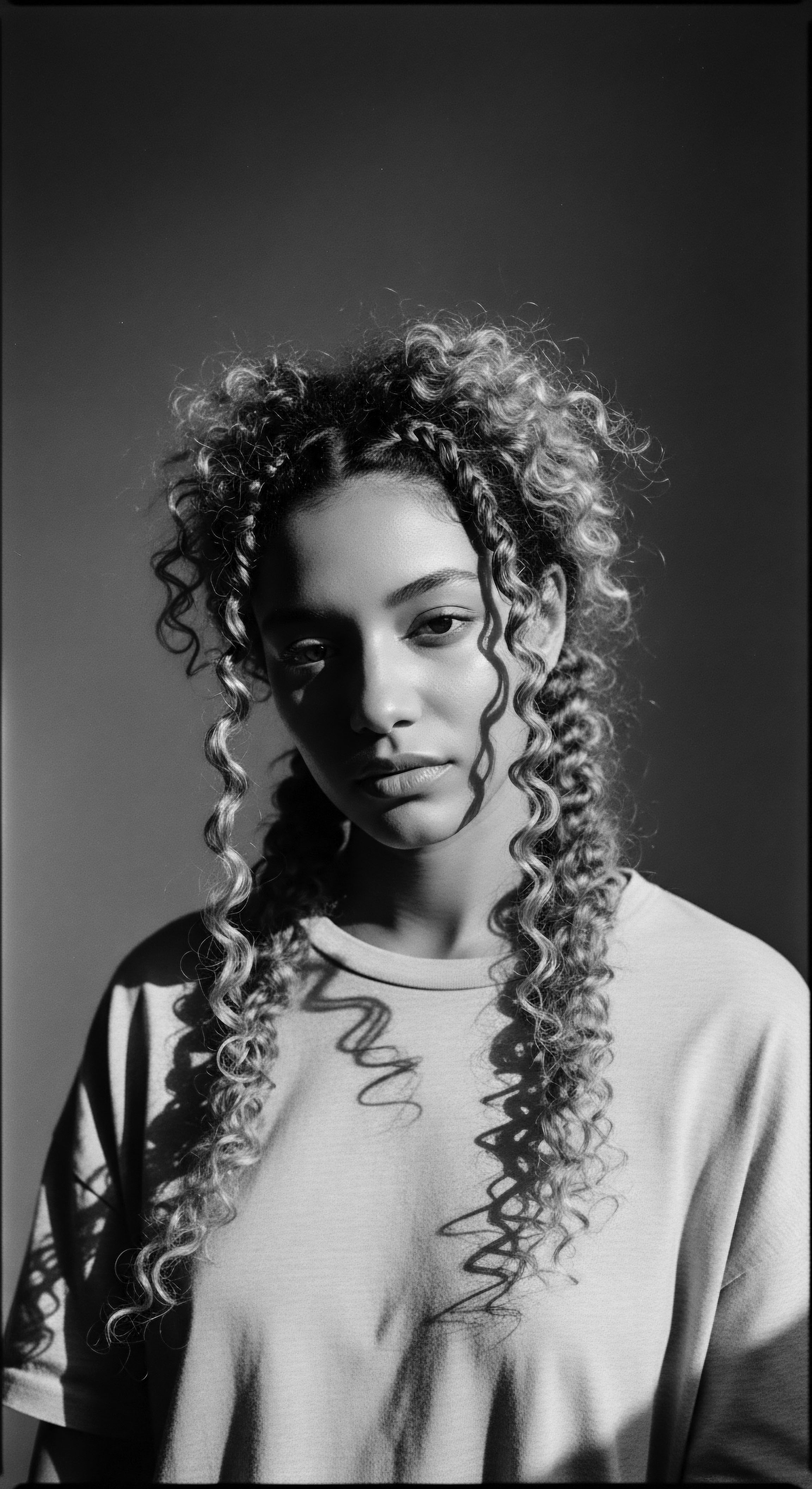
Roots
There exists a certain intimacy, a quiet understanding, that settles upon the hands when they tend to textured coils. It is a dialogue spanning generations, a whispered wisdom passed through touch, a recognition of living heritage in every strand. To ponder whether natural clays truly benefit textured coils is not to seek a simple yes or no.
It is to embark on a journey into the elemental, into the very earth that cradled ancient hands and inspired their care practices. These questions lead us to the deep history written in our hair, a history connecting us to ancestral ways of life, to communal rituals, and to a profound sense of self that roots in the soil beneath our feet.

Hair’s Elemental Blueprint
Textured hair, with its unique architecture of bends and spirals, presents a wondrous biological marvel. Each curve in the hair shaft, a testament to its elliptical cross-section, influences how light reflects, how moisture is held, and how substances interact with its surface. From a molecular perspective, hair comprises keratin proteins, lipids, and trace minerals. The outer cuticle, an overlapping layer of scales, acts as a protective shield.
When we consider the history of care for such hair, ancient communities recognized its delicate balance, even without the language of modern science. Their observational wisdom, honed over millennia, led them to the earth’s bounty for solutions.
Consider the very makeup of clays themselves. These finely grained minerals, shaped by geological ages, carry a negative electrical charge. When hydrated, they act like tiny magnets, drawing out positively charged impurities such as product buildup, environmental pollutants, and excess sebum from the hair and scalp.
This fundamental interaction, a dance of charges, forms the core of clay’s cleansing and detoxifying capabilities. The practice of using such earthen compounds connects directly to the earliest human understandings of purification and restoration, a legacy preserved through traditional knowledge systems.
The tending of textured coils represents a living heritage, a quiet understanding conveyed across generations through touch and ancestral wisdom.

Ancestral Wisdom and Hair Anatomy
Long before microscopes revealed the intricate details of a hair shaft, communities across the African continent and its diaspora possessed an intuitive grasp of hair’s needs. They understood that a healthy scalp was the bedrock for robust hair. They observed the effects of different natural substances on various hair types, developing sophisticated systems of care.
The knowledge of how certain plants and minerals could cleanse without stripping, or nourish without weighing down, was painstakingly accumulated. This ancestral understanding forms the very foundation upon which modern hair science now builds, validating many practices once dismissed as mere folklore.
The nomenclature of textured hair, too, holds historical echoes. While contemporary classification systems (like 3A to 4C) aim for scientific precision, older descriptions, passed down verbally, often focused on qualities like resilience, strength, and softness, or even on the hair’s spiritual significance. The term “coils” itself, rather than implying uniformity, evokes the spring-like elasticity and intricate patterns that are deeply characteristic of this hair type. These descriptions, whether ancient or modern, attempt to capture the singular beauty of hair that defies simple categorization.
- Kaolin Clay ❉ Known to have been used in various African communities for skin beautification and ritualistic purposes, suggesting early recognition of its mild, purifying qualities for hair and scalp.
- Bentonite Clay ❉ Utilized by various indigenous cultures, including some African tribes and Native American communities, to soothe irritated skin and cleanse the body, practices that implicitly extended to hair care.
- Rhassoul Clay ❉ Harvested from the Atlas Mountains of Morocco, this clay has been a staple in North African beauty rituals for centuries, revered for its ability to cleanse and condition hair without harsh stripping.

When Did Ancient Peoples Turn to Earth for Hair Care?
The turning to earth for hair care is not a recent discovery; its origins are lost in the mists of antiquity. From the Himba people of Namibia, whose women traditionally adorn their thick braids with otjize – a blend of butterfat and red ochre pigment – we discern a practice serving both aesthetic and hygienic purposes. The otjize mixture, passed down through generations, shields hair and scalp from the harsh desert climate and, as it flakes away, carries with it dirt and dead skin cells (Chikumbirike, 2024; van der Geer, 2022). This profound practice demonstrates an early understanding of clay’s cleansing, protective, and cosmetic attributes, deeply woven into their cultural identity.
Similarly, ancient Egyptians employed clays for cleansing and detoxifying both skin and hair, as evidenced by archaeological discoveries and historical texts. These early innovators, recognizing the adsorptive capacities of clays, incorporated them into rituals for purification and beauty, laying groundwork for future generations to follow.
The widespread use of clays across diverse ancient civilizations points to a shared ancestral recognition of their intrinsic benefits. This collective wisdom, developed through generations of observation and experimentation, highlights that the efficacy of natural clays for textured coils is not a modern revelation but a reaffirmation of practices that stood the test of time.

Ritual
The art of textured hair styling is a living manuscript, penned by ancestral hands and continually edited by contemporary expression. Within this enduring practice, natural clays have held a quiet yet persistent presence, shaping not just the appearance of coils but also the communal and individual experience of hair care. The methods, tools, and transformations wrought by clay applications speak volumes about traditional ingenuity and cultural resilience. Hair, in these contexts, becomes a canvas for self-identification, historical continuity, and shared understanding.

Clays as Traditional Styling Allies
Beyond simple cleansing, clays found their place within intricate styling traditions. The plasticity of wet clay, its ability to hold shape upon drying, rendered it a valuable component for achieving specific looks or for maintaining protective styles. In various communities, mixtures incorporating clays might have been applied to braids or locs, providing a firm yet flexible hold, while simultaneously conditioning the hair. This dual functionality speaks to a practical wisdom that prioritized health alongside artistry.
Imagine the preparation ❉ the rhythmic grinding of dried clay, the slow mixing with water or botanical infusions, the shared laughter and stories as skilled hands worked the paste into hair. These moments were as much about social cohesion as they were about hair care.
Consider the traditional uses of clay for hair definition. For centuries, individuals found ways to enhance the natural curl patterns inherent to textured hair. Clay’s gentle hold could help clump coils together, promoting definition without rigidity.
This approach honored the hair’s natural inclination, allowing its innate beauty to come forth. The methods were often gentle, relying on the clay’s properties rather than harsh manipulation, thereby preserving the integrity of the delicate hair strands.
The historical use of natural clays in hair rituals points to an enduring legacy where functional benefits and artistic expression harmoniously converge.

The Evolving Toolkit of Textured Hair
The tools associated with textured hair care have also changed, yet the principles of gentle handling and purposeful application remain constant. From ancestral combs carved from wood or bone, designed to navigate intricate coils without tearing, to the simple clay bowls where mixtures were prepared, each item held its purpose. These tools served as extensions of the hands, aiding in the meticulous work of hair dressing, a practice often performed communally. The application of clay, whether for cleansing or styling, became a practiced motion, a ritualistic gesture passed down through observation and participation.
Even today, modern implements often seek to replicate the efficacy of these traditional approaches. The broad-toothed comb, for instance, echoes the functionality of its wooden predecessors, prioritizing detangling with minimal breakage. The very act of preparing a clay mask at home today, mixing a dry powder with liquid, mirrors ancient preparations, bridging centuries of hair care wisdom.
| Aspect Cleansing |
| Traditional Application (Heritage Link) Used by Himba women in otjize and ancient Egyptians for purification, removing dirt and impurities from hair and scalp without harsh stripping. |
| Modern Application (Scientific Understanding) Employed as natural shampoos or detox masks, adsorbing excess sebum and product residue while maintaining the scalp's delicate balance. |
| Aspect Conditioning |
| Traditional Application (Heritage Link) Rhassoul clay mixed with water yielded a soft paste that left hair silky; applied for softness and manageability in Moroccan traditions. |
| Modern Application (Scientific Understanding) Incorporated into hair masks to impart minerals, smooth the cuticle, reduce frizz, and enhance curl definition, promoting a soft texture. |
| Aspect Styling & Hold |
| Traditional Application (Heritage Link) Clays sometimes added to styling mixtures to provide mild hold for traditional braids and intricate coiffures, aiding structural integrity. |
| Modern Application (Scientific Understanding) Used in curl-defining creams or as a pre-styling treatment to clump coils, enhancing natural curl patterns and providing a soft, flexible hold. |
| Aspect Scalp Wellness |
| Traditional Application (Heritage Link) Applied in ancient Egyptian rituals for detoxification of the skin, extending to the scalp for a purified foundation for hair growth. |
| Modern Application (Scientific Understanding) Reduces dandruff and soothes irritation by absorbing excess sebum and possessing antimicrobial properties, fostering a healthy scalp environment. |
| Aspect Clays hold a consistent place in textured hair care, their historical and contemporary applications demonstrating enduring benefits. |

How Did Clay Rituals Shape Community and Identity?
The application of clay for hair care, particularly within textured hair communities, was frequently a communal endeavor. In many African societies, hair dressing was not a solitary act but a social occasion, a moment for bonding, storytelling, and the transmission of knowledge. Young girls observed their elders, learning the intricate techniques of braiding, twisting, and applying traditional preparations. This shared space for hair care reinforced familial ties and community bonds.
The resulting hairstyles, often adorned with clays or other natural elements, served as visual markers of identity – signaling marital status, age, or tribal affiliation. The practice connected individuals to their collective heritage, strengthening a sense of belonging and cultural pride. The way hair was cared for, shaped, and adorned was a living testament to cultural values and historical continuity. The very act of cleansing and beautifying hair with the earth’s gifts was a reaffirmation of connection to the land and to a deep, ancestral self-understanding. It was a practice rooted in respect, both for the hair and for the hands that cared for it.

Relay
The journey of natural clays in textured hair care extends beyond ancient traditions, relaying ancestral wisdom into contemporary regimens. Today, the benefits observed by our forebears are increasingly understood through scientific inquiry, creating a powerful synergy between old-world practices and modern understanding. This section bridges the timeless efficacy of clays with their role in comprehensive holistic care and targeted problem-solving for textured coils, all viewed through the enduring lens of heritage.

Integrating Clays into Personalized Regimens
Crafting a personalized hair regimen for textured coils demands a thoughtful selection of ingredients, a practice echoing the ancestral discernment of beneficial botanicals and minerals. Natural clays offer a foundational element, acting as gentle yet powerful cleansers and purifiers. For those seeking to minimize harsh detergents, clay washes provide an alternative that respects the hair’s natural moisture balance. They prepare the scalp and strands for subsequent conditioning and styling, creating a clean canvas without stripping away essential oils.
The selection of a particular clay, whether kaolin, bentonite, or rhassoul, can be tailored to individual needs, a testament to the versatility of these gifts from the earth. This adaptability allows individuals to customize their care, much as ancestral communities adapted their practices to local resources and specific hair types. The goal remains the same ❉ a healthy, vibrant crown.
The traditional wisdom of listening to one’s hair and body finds resonance in contemporary holistic wellness. Hair health is viewed as an extension of overall well-being, influenced by diet, hydration, and stress levels. Clays fit seamlessly into this philosophy. Their mineral content—rich in silica, magnesium, calcium, and iron—offers not only surface benefits but also a subtle nourishment that aligns with a holistic approach to hair care.
(Brennan, 2021) The act of preparing and applying a clay mask becomes a moment of mindfulness, a pause in the daily rush, reconnecting us to a slower, more deliberate pace of self-care that once defined ancestral beauty practices. This ritualistic aspect helps to calm the spirit as much as it benefits the strands.

The Nighttime Sanctuary and Clay’s Role?
Nighttime care, a often overlooked but supremely important component of textured hair health, finds an interesting connection with the principles of clay cleansing. Protecting coils during sleep minimizes friction, preserves moisture, and prevents tangles. While clays themselves are typically used as wash treatments, the philosophy underpinning clay usage—gentle detoxification and respect for natural oils—informs the selection of products for overnight routines. A clean, balanced scalp from a clay wash might be followed by a nourishing oil or leave-in, secured with a silk bonnet.
The bonnet, too, carries its own heritage, evolving from headwraps worn for protection and adornment across African cultures. This protective layering, from cleansing to covering, extends the benefits of the daytime regimen into the nocturnal hours, ensuring hair remains protected and retains its vitality.
The wisdom embedded in bonnets, wraps, and protective styles during sleep reflects a long-standing understanding of how to preserve hair. This understanding, whether applied to intricate traditional updos or simpler nightly coverings, underscores the continuous care required for textured hair. Clays, in their role as deep cleansers, ensure that the hair entering its nighttime sanctuary is free from accumulated residue, allowing any overnight treatments to work effectively and allowing the scalp to breathe. This thoughtful, continuous care is a legacy passed down, emphasizing maintenance as a key to long-term hair health and beauty.

Clays for Textured Hair Needs
Natural clays present compelling solutions for common textured hair challenges, drawing upon their unique mineral compositions and adsorptive properties. For instance, Bentonite clay , formed from aged volcanic ash, holds a strong negative ionic charge, making it exceptionally effective at drawing out positively charged impurities like product buildup and heavy metals from the scalp and hair. This deep cleansing action restores a ‘clean slate’ for the hair, allowing follicles to breathe and promoting healthier growth. Its ability to absorb excess sebum also makes it particularly helpful for oily scalps or for clarifying hair after prolonged use of heavy products.
Conversely, Kaolin clay , often considered one of the mildest clays, provides a gentler cleansing experience, suitable for those with sensitive scalps or hair prone to dryness. It purifies without over-stripping, preserving the hair’s natural hydration. Rhassoul clay , unique to Morocco’s Atlas Mountains, stands out for its high mineral content, including silica, magnesium, and calcium. It not only cleanses but also conditions, leaving coils feeling soft, defined, and detangled, without compromising their natural elasticity. This broad spectrum of benefits across different clay types allows for precise tailoring to address specific needs.
The application methods often mirror ancient practices. Clays are typically mixed with water to form a smooth paste, often with additions like apple cider vinegar for pH balancing, or aloe vera juice for added moisture. This simple preparation, akin to ancestral concoctions, transforms raw earth into a potent hair treatment. After application, the clay draws out impurities, and upon rinsing, the hair feels refreshed and revitalized.
This gentle, non-lathering cleanse respects the delicate structure of coils, preventing the dryness often associated with harsh sulfates found in conventional shampoos. The enduring efficacy of these natural substances in cleansing and conditioning textured hair speaks to an inherent wisdom in selecting ingredients that work in harmony with the hair’s biological needs, a testament to inherited knowledge.
- Ingredient Efficacy ❉ Different clays possess varying mineral compositions and adsorptive capacities, allowing for tailored benefits, a nuance understood through centuries of empirical observation.
- Scalp Health ❉ Clays cleanse the scalp by drawing out impurities and excess sebum, creating a clean environment conducive to healthy hair growth and addressing issues like flakiness.
- Moisture Balance ❉ Unlike harsh detergents, clays can cleanse without excessively stripping natural oils, helping textured coils retain moisture and prevent dryness, aligning with ancestral practices of non-stripping care.

Addressing Hair Concerns Through Ancient Wisdom
Many modern hair concerns, from chronic dryness to product buildup, are not entirely new; they are variations on challenges faced by our ancestors. The solutions found in antiquity often relied on the inherent properties of natural materials. The ability of clays to detoxify and remove accumulation, for instance, addresses one of the most common issues for textured coils ❉ the persistent residue from styling products. This buildup can impede moisture absorption and lead to dull, lifeless hair.
A clay wash provides a potent yet gentle reset, clearing the path for subsequent moisturizing treatments to be truly effective. The practice of “resetting” the hair and scalp aligns with traditional cleansing rituals aimed at maintaining purity and health.
The tradition of applying natural substances to soothe the scalp and promote circulation also finds modern validation. A healthy scalp is the prerequisite for healthy hair. Clays, by virtue of their mineral content and their ability to cleanse deeply, help to calm an irritated scalp and minimize conditions like dandruff, fostering an optimal environment for hair growth.
This continuum of care, from elemental purification to long-term scalp health, underscores the timeless relevance of ancestral practices. The ongoing dialogue between scientific understanding and inherited wisdom continues to illuminate the profound benefits of natural clays for textured coils, reinforcing their rightful place in a holistic hair care heritage.

Reflection
To truly understand whether natural clays benefit textured coils is to stand at the crossroads of ancient wisdom and contemporary science, witnessing how the echoes of ancestral practices resound in our present-day regimens. The journey through the ‘Soul of a Strand’ ethos reveals that the efficacy of these earthen treasures extends beyond mere cosmetic application. It speaks to a profound connection to heritage, to the ingenuity of those who first turned to the earth’s bounty for their hair’s sustenance, and to the enduring power of traditions passed down through generations. Clays, in their very composition, carry the memory of geological time, offering a tangible link to the elemental sources of life and care.
Their continued use is not a nostalgic gesture but a living affirmation of practices that intuitively understood the unique needs of textured coils. Our coils are more than strands; they are conduits to a vibrant past, a resilient present, and a future where ancestral knowledge shines as a guiding light.

References
- Brennan, D. (2021). “What to Know About Rhassoul Clay.” Retrieved from
- Chikumbirike, E. (2024). “A Crowning Glory ❉ Hair as History, Identity, and Ritual.” Khumbula.
- Ecosystem Laboratoire. (2024). “Ghassoul ❉ history, benefits and uses.”
- Pure Body Naturals. (2025). “How to Use Bentonite Clay and Its Many Benefits.”
- Rastta Locs. (2024). “Rhassoul Clay ❉ A Moroccan Treasure for Hair Health.”
- Regirl. (2021). “Bentonite Clay For Natural Hair ❉ Benefits, How to Use, and DIY Mask Recipe.”
- Rthvi. (2024). “Exploring Ancient Hair Care Rituals ❉ Timeless Practices for Modern Hair Wellness.”
- Sabinet African Journals. (2024). “Indigenous knowledge applied to the use of clays for cosmetic purposes in Africa ❉ an overview.”
- Santora, R. (2022). “5 Ways to Use Ancient Healing Clay.” Heritage Store.
- van der Geer, D. (2022). “Otjize.” Wikipedia.
